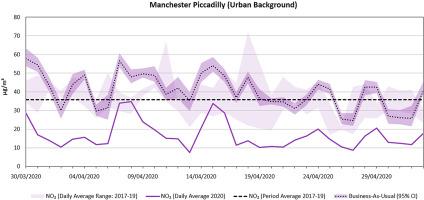Environmental Pollution ( IF 7.6 ) Pub Date : 2020-11-20 , DOI: 10.1016/j.envpol.2020.116011 Calvin Jephcote , Anna L. Hansell , Kathryn Adams , John Gulliver

|
The UK implemented a lockdown in Spring 2020 to curtail the person-to-person transmission of the SARS-CoV-2 virus. Measures restricted movements to one outing per day for exercise and shopping and otherwise most people were restricted to their dwelling except for key workers (e.g. medical, supermarkets, and transport). In this study, we quantified changes to air quality across the United Kingdom from 30th March to 3rd May 2020 (weeks 14-18), the period of most stringent travel restrictions. Daily pollutant measurements of NO2, O3 and PM2.5 from the national network of monitoring sites during this period were compared with measurements over the same period during 2017-19. Comparisons were also made with predicted concentrations for the 2020 period from business-as-usual (BAU) modelling, where the contributions of normal anthropogenic activities were estimated under the observed meteorological conditions. During the lockdown study period there was a 69% reduction in traffic overall (74% reduction in light and 35% in heavy vehicles). Measurements from 129 monitoring stations, identified mean reductions in NO2 of 38.3% (-8.8 μg/m3) and PM2.5 of 16.5% (-2.2 μg/m3). Improvements in NO2 and PM2.5 were largest at urban traffic sites and more modest at background locations where a large proportion of the population live. In contrast, O3 concentrations on average increased by 7.6% (+4.8 μg/m3) with the largest increases at roadside sites due to reductions in local emissions of NO. A lack of VOC monitoring limited our capacity to interpret changes in O3 at urban background locations. BAU models predicted comparable NO2 reductions and O3 gains, although PM2.5 episodes would have been more prominent without lockdown. Results demonstrate the relatively modest contribution of traffic to air quality, suggesting that sustained improvements in air quality require actions across various sectors, including working with international and European initiatives on long-range transport air pollutants, especially PM2.5 and O3.
中文翻译:

英国COVID-19“封锁”期间的空气质量变化
英国于2020年春季实施了封锁措施,以遏制SARS-CoV-2病毒的人际传播。该措施将运动和购物限制为每天一次郊游,否则,除了关键工人(例如医疗,超级市场和运输)外,大多数人只能住所。在这项研究中,我们量化来自30整个英国改变空气质量日日至3次2020年5(14-18周),最严格的旅行限制的时期。NO 2,O 3和PM 2.5的每日污染物测量在此期间,将国家监控站点网络中的数据与2017-19年同期的数据进行了比较。还通过照常营业(BAU)建模与2020年期间的预测浓度进行了比较,在这种情况下,在观测的气象条件下估算了正常人为活动的贡献。在锁定研究期间,总体交通量减少了69%(轻型车辆减少了74%,重型车辆减少了35%)。来自129个监测站的测量结果表明,NO 2的平均减少量为38.3%(-8.8μg/ m 3),PM 2.5的平均减少量为16.5%(-2.2μg/ m 3)。NO 2和PM 2.5的改进在城市交通站点中最大,而在人口众多的居住背景站点中则较少。相反,由于当地NO排放量的减少,O 3的平均浓度增加了7.6%(+4.8μg/ m 3),在路边站点的增加最大。缺乏挥发性有机化合物监测限制了我们解释城市背景下O 3变化的能力。尽管PM 2.5,BAU模型预测NO 2的减少和O 3的增加具有可比性没有锁定的情节本来会更加突出。结果表明交通对空气质量的贡献相对较小,这表明持续改善空气质量需要跨各个部门采取行动,包括与国际和欧洲就远程运输空气污染物(尤其是PM 2.5和O 3)开展合作。











































 京公网安备 11010802027423号
京公网安备 11010802027423号